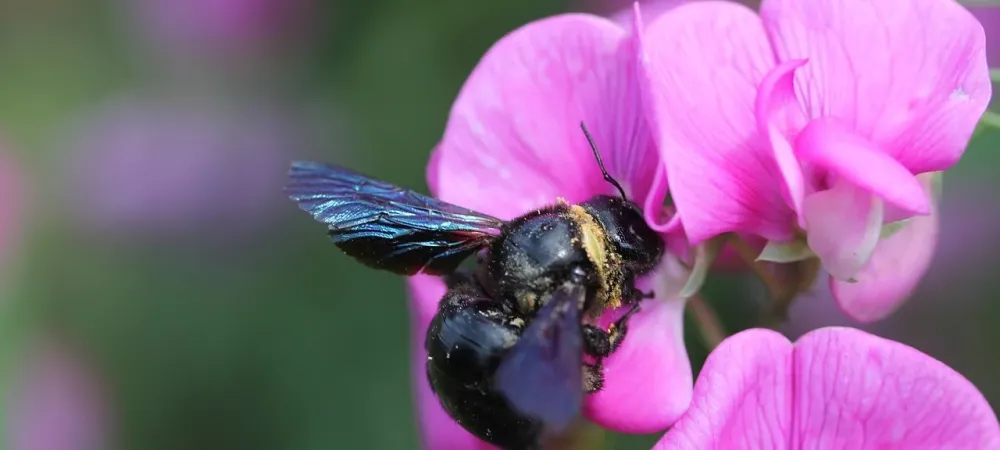How to Prevent Carpenter Bees

Carpenter bees like to burrow and nest in wood, which is how they get their name. They create perfectly round holes in the wooden areas of your home, often leaving behind small piles of sawdust. These wood-destroying insects aren’t as bad as termites, but that doesn’t mean they’re welcome in your home. We’ll go over the basics about carpenter bees, plus how to prevent them from becoming a problem.
Quick Overview of Carpenter Bee Prevention
What Carpenter Bees Hate Most:
-
Strong Smells - Citrus scents like orange, lime, lemon
- Loud vibrations - Music and wind chimes
- Painted wood - They prefer raw, untreated surfaces
Preventative Actions:
- Fill existing holes with steel wool + caulk
- Install wind chimes near vulnerable areas
- If you see new holes or small piles of sawdust, then call a pest professional
Prevention Timeline:
- March-April: Apply first preventive treatment
- May-July: Peak activity - weekly inspections
- August-October: Seal abandoned holes
- November-February: Paint/stain exposed wood
How Do You Keep Carpenter Bees Away?
There are a variety of ways to keep carpenter bees away before they actually become a problem. A few of the most effective ways include:
- Paint or stain exposed wood: Carpenter bees prefer untreated wood, so painting or staining it makes it more unappealing to them.
- Build with hardwood: Hardwood is denser and more complex than softwood. Using oak, cherry, or ash makes it more difficult for carpenter bees to burrow.
- Use vinyl siding: Unlike wood siding, vinyl doesn’t attract carpenter bees and actually protects the softwood it’s covering.
- Seal cracks and holes: Carpenter bees seek out existing holes and nests. By sealing them, you increase the odds that bees will search for a home elsewhere.
Carpenter Bee Prevention Calendar: Year-Round Protection Strategy
Early Spring (March - April)
Why it matters: Queen bees emerge from hibernation seeking nesting sites
-
Week 1-2 March: Inspect all wood surfaces for old holes
- Week 3-4 March: Apply first almond oil to vulnerable areas
- Mid-April: Paint or stain any untreated wood
Critical task: Fill ALL existing holes with steel wool and wood putty before bees become active
Late Spring (May - June)
Why it matters: Peak mating and nesting season
- May: Apply citrus spray weekly to active areas
- Early June: Check for new holes every 3 days
- Mid-June: Refresh almond oil applications
- Late June: Install additional wind chimes near new activity
Critical task: Treat new holes immediately - within 24 hours of discovery
Summer (July - August)
Why it matters: Second generation emerges, expanding existing tunnels
- July: Increase inspection frequency to twice weekly
- Late August: Begin end-of-season hole sealing
Critical task: Document all hole locations for fall treatment
Fall (September - October)
Why it matters: Bees prepare for winter hibernation
- Early October: Seal all holes with steel wool and caulk
- Mid-October: Apply protective wood sealant
Critical task: Complete all repairs before first frost
Winter (November - February)
Why it matters: Preparation and maintenance period
- November-December: Purchase next season's supplies
- January: Plan wood replacement projects
- February: Early inspection for weather damage
Critical task: Schedule professional inspection for March
What Do Carpenter Bees Hate The Most?
Carpenter bees have strong aversions to specific scents, sounds, and surfaces. Understanding these preferences helps create an inhospitable environment that naturally deters them from your property.
Citrus Oils and Peels
Carpenter bees strongly dislike citrus scents, particularly orange and lemon. The d-limonene compound in citrus acts as a natural repellent.
Loud Noise and Vibrations
Carpenter bees are extremely sensitive to vibrations. Installing wind chimes, playing loud music, or using ultrasonic devices near nesting areas drives them away.
Effective sound deterrents:
- Metal wind chimes (create constant vibration)
- Bass-heavy music (20-30 minutes daily)
- Ultrasonic pest repellers (20-40 kHz range)
Paint and Wood Stains
Carpenter bees hate painted or stained wood because it's harder to excavate and lacks the natural wood scent they seek. Polyurethane-based stains are particularly effective.
Most effective finishes:
- Oil-based paints (any color)
- Polyurethane wood stain
- Metallic paint (contains aluminum)
Synthetic Wood and Vinyl
Carpenter bees cannot penetrate synthetic materials. Installing vinyl siding, composite decking, or PVC trim eliminates potential nesting sites.
Don't let unwanted pests compromise your comfort and safety another day. With over 51 years of family-owned expertise, Suburban Pest Control offers fast, discreet solutions tailored to your needs. Our dedicated team of professionals stands ready to eliminate your pest problems while upholding our core values of integrity, teamwork, and exceptional service. Contact us today for a consultation and experience the peace of mind that comes with entrusting your home or business to a company that has been protecting our community since 1974.
Serving Westchester County and Surrounding Area
Can Carpenter Bees Destroy A Deck?
Yes, carpenter bees can cause significant damage to decks over time. While they don't eat wood, their tunneling can weaken deck boards and railings. A severe infestation can compromise structural integrity within 3-5 years. Soft woods like pine and cedar are most vulnerable.
Can Carpenter Bees Sting You?
Yes, Carpenter bees can sting you, but only some of them. Female carpenter bees are the ones who have stingers, and they’re capable of stinging more than once. However, they’re unlikely to do so unless you provoke them by attempting to handle them or poking your fingers into their burrows. Male carpenter bees are the ones you’ll see guarding the nest and while they might act aggressively by flying at you, they can’t sting you.
Do Carpenter Bee Traps Really Work?
Carpenter bee traps are only 70% effective even when properly placed and maintained. Always consult with a professional pest control company to avoid danger to you or your loved ones and to address infestations quickly and effectively.
Do Carpenter Bees Come Back To The Same Place Every Year?
Yes, carpenter bees often return to the same locations annually. Young bees frequently reuse and expand old tunnels created by previous generations. This behavior makes sealing old holes in fall (September-October) crucial for preventing future infestations. Female bees can detect old nests from up to 50 feet away.
What Attracts Carpenter Bees?
Like other bees, carpenter bees are attracted to flowers. If you have lots of flowers in your yard, you’ll likely find these bees mingling with bumblebees, butterflies, and other pollinators. They’re also attracted to untreated wood, which can make fences, decks, and sheds, as well as wood siding. Carpenter bees also search for old nests that they can use and expand.
What Do Carpenter Bees Eat?
Contrary to popular belief, carpenter bees don’t eat wood—they use their mandibles to carve out tunnels, then push the sawdust out. Instead, Carpenter bees eat nectar like other bees. Carpenter bees feed their larvae “bee bread,” which is a mixture of pollen and nectar or honey.
What Is The Fastest Way To Get Rid Of Carpenter Bees?
The fastest and safest method to address an infestation is to contact your local pest control company to identify the level of infestation and address any access points.
What Time Of Day Are Carpenter Bees Most Active?
Carpenter bees are most active during warm, sunny afternoons between 11 AM and 4 PM. They're least active at dawn and dusk, making evening (after 7 PM) the safest and most effective time to apply treatments or seal holes.
What's The Difference Between Carpenter Bees And Bumblebees?
Carpenter bees have shiny, black, hairless abdomens while bumblebees are fuzzy all over with yellow stripes. Carpenter bees are solitary and drill into wood; bumblebees are social and nest in the ground. Carpenter bees hover aggressively but males can't sting; bumblebees are generally docile but all can sting.
Will Carpenter Bees Eventually Go Away On Their Own?
No, carpenter bees will not go away on their own. Without intervention, populations increase yearly as new generations expand existing tunnels. A single untreated hole can become a 10-foot gallery system within 2-3 years, potentially causing structural damage.
